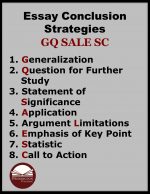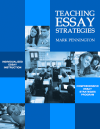
TEACHING ESSAYS BUNDLE
The Writing Process and Writers Workshop are not simply processes by which students explore and refine their writing on their own. The teacher plays an active role in teaching and modeling the writing strategies that students need to acquire to become coherent writers. Both explicit and implicit instruction have their appropriate roles within writing instruction. Creating and maintaining an experimental community of writers is no easy task for the writing instructor. However, the pay-offs are certainly worth the effort.
The diverse classroom provides unique challenges for both students and writing instructor. By its very nature, much of writing instruction is differentiated instruction. Classroom management and creation of a workable writing climate are essentials to successful learning.
Following are articles, free resources, and teaching tips regarding how to facilitate the Writing Process and Writers Workshop from the Pennington Publishing Blog. Also, check out the quality instructional programs and resources offered by Pennington Publishing.
The TEACHING ESSAYS BUNDLE consists of three essential writing resources: How to Teach Essays, Essay Skills Worksheets, and Eight Writing Process Essays.
How Much and What to Mark on Essays
https://blog.penningtonpublishing.com/grammar_mechanics/how-much-and-what-to-mark-on-essays/
Many teachers take pride in red-inking student essays: the more ink the better. Some “grade” essays without comments by using holistic or analytical rubrics, but do not mark papers. For those who still assign writing process essays and/or essay exams and believe that students can and do benefit from comments, the question of How Much and What to Mark on Essays is relevant. Work smarter, not harder, while focusing on efficiency and outcomes.
How to Teach Writing Skills
https://blog.penningtonpublishing.com/writing/how-to-teach-writing-skills/
Two time-proven solutions to these problems take little time, but do necessitate some instruction and practice: sentence revisions and literary response. Writing teachers (and writing research) have found these tools to be especially helpful for developing writers.
By sentence revision, I mean the word choice and structure of our language (the grammar, usage, and syntax). It’s the how something is written (and re-written). Think sentence variety, sentence combining, grammar and proper usage in the writing context. The skills of sentence revision are primarily taught.
By literary response, I mean writing style: primarily the style of literary mentors, who not only have something to say, but know how to say it in both expository and narrative writing. Think mentor texts and rhetorical stance (voice, audience, purpose, and form). The skills of writing style are primarily caught.
How to Write Effective Essay Comments
https://blog.penningtonpublishing.com/writing/how-to-write-effective-essay-comments/
Conscientious teachers know that merely completing a holistic rubric and totaling the score for a grade is not effective essay response or writing assessment. Teachers may choose to grade and/or respond with essay comments after the rough draft and/or after the final draft. Using the types of comments that match the teacher’s instructional objectives is essential. Additionally, keeping in mind the key components of written discourse can balance responses between form and content. Finally, most writing instructors include closing comments to emphasize and summarize their responses. Here’s how to write truly effective essay comments.
The Difference between Facts and Claims
https://blog.penningtonpublishing.com/spelling_vocabulary/the-difference-between-claims-and-facts/
This article discusses the important differences between a fact and a claim. Plus, learn how knowing the differences should affect your teaching the argumentative essay.
Using Evidence in Writing
https://blog.penningtonpublishing.com/writing/using-evidence-in-writing/
Teaching students to use appropriate evidence in argumentative essays is a difficult task. Students generally understand how to use textual evidence in direct and indirect quotations, but are less adept at creating reasons apart from the text itself. Teach your students the eight types of essay evidence with the memorable FE SCALE CC strategies.
How Much and What to Mark on Essays
https://blog.penningtonpublishing.com/grammar_mechanics/how-much-and-what-to-mark-on-essays/
For those who still assign writing process essays and/or essay exams and believe that students can and do benefit from comments, the question of How Much and What to Mark on Essays is relevant. Working smarter, not harder and focusing on efficiency and outcomes over pedagogical purity are worthy mantras for effective writing instruction.
How to Dissect a Writing Prompt
https://blog.penningtonpublishing.com/writing/how-to-dissect-a-writing-prompt/
Knowing exactly what the writing assignment requires in terms of the audience, role of the writer, topic and its context, purpose of the essay, essay format, resource text, and key writing direction words are all necessary components of this task. Following is a step-by-step procedure for dissecting a writing prompt.
How Many Essay Comments and What Kind
https://blog.penningtonpublishing.com/writing/how-many-essay-comments-and-what-kind/
So, to summarize how many essay comments and what kind, writing research would suggest the following: Comment on rough drafts, not final drafts. Limit the amount of comments and individualize those to the needs of the student writer. Balance the types of comments between writing errors and issues of style, argument, structure, and evidence. Hold students accountable for each mark or comment. Comments are better than diacritical marks alone. Comments should explain what is wrong or explain the writing issue.
Writer’s Workshop Mini-Conferences
https://blog.penningtonpublishing.com/grammar_mechanics/writers-workshop-mini-conferences/
With Writer’s Workshop, teachers typically organize a one-hour workshop so that at least half of the time is devoted to writing, peer conferences, and writer-teacher mini-conferences. Properly managed, the writer-teacher mini-conference can be a key ingredient to the success of developing writers. Here are some tips to make the most out of Writer’s Workshop Mini-Conferences and some great attachments, links, and free downloads as well.
Differentiating Instruction in Writer’s Workshop
https://blog.penningtonpublishing.com/grammar_mechanics/differentiating-instruction-in-writer%E2%80%99s-workshop/
Critics of Writer’s Workshop often complain that Writer’s Workshop can be inefficient and/or a class management nightmare. Some teachers have tried Writer’s Workshop, but have given up because the workshop is interest-based, not standards-based or because it is student-centered, not teacher-centered. Neither of those criticisms concerns me greatly. However, I do feel that the traditional model of Writer’s Workshop is not as conducive to differentiated instruction as it could be. Specifically, tweaking the mini-lesson will allow teachers to better differentiate instruction within Writer’s Workshop.
Analytical Rubrics
https://blog.penningtonpublishing.com/writing/analytical-rubrics/
Teachers use two types of rubrics to assess student writing: holistic and analytic. Of the two rubrics, the analytical rubric offers both teachers and students much more to work with to improve student writing. Here are five reasons why using analytical rubrics makes sense.
What’s Wrong with Holistic Rubrics?
https://blog.penningtonpublishing.com/writing/whats-wrong-with-holistic-rubrics/
It’s a relatively easy task to criticize any measure of writing assessment. This is my chore in What’s Wrong with Holistic Rubrics. We should use holistic rubrics for many writing assessments. However, we shouldn’t use holistic rubrics to teach writing. Holistic rubrics are, by design, summative assessments. Summative assessment is limited to evaluation, and evaluation is not instruction.
20 Tips to Teach Writing through Music
https://blog.penningtonpublishing.com/writing/20-tips-to-teach-writing-through-music/
Students have internalized the structure, syntax, and rules of music far more than that of any writing genre. This prior knowledge is simply too valuable for the writing teacher to ignore. Analyzing the songwriting composition process will enable students to apply the relevant strategies to their own writing of narratives, poetry, essays, and reports (and maybe even songs).
How to Teach a Science of Writing Program
https://blog.penningtonpublishing.com/reading/how-to-teach-a-balanced-writing-program/
Teachers want to apply the Science of Writing in their writing instruction. No one wants to throw away explicit grammar, spelling, and writing strategies instruction or the writing process. In a previous article, I have made the case that a balanced writing program makes sense. Learn the six steps to take to develop a balanced and effective writing program.
Using Music to Develop a Productive Writing Climate
https://blog.penningtonpublishing.com/writing/using-music-to-develop-a-productive-writing-climate/
Using the craft of songwriting as a guide, the writing teacher can develop a productive writing climate. Combining resources, collaboration, and competition with an atmosphere of social networking can improve student motivation, commitment, and end product.
Using Music to Develop a Creative Writing Culture
https://blog.penningtonpublishing.com/writing/using-music-to-develop-a-creative-writing-culture/
Music, and songwriting in particular, can help teachers develop a creative writing culture. Learning the lessons of musical composition can improve student writing.
Ten Tips for Coaching Basketball and Writing
https://blog.penningtonpublishing.com/grammar_mechanics/ten-tips-for-coaching-basketball-and-writing/
Learning to apply the coaching techniques of an effective basketball coach will significantly improve your ability as a writing coach for your students. Learn the ten tips to change from “the sage on the stage” to the “guide on the side.”
How to Write an Effective Essay Prompt
https://blog.penningtonpublishing.com/writing/how-to-write-an-effective-essay-prompt/
Writing effective writing prompts that will engage writers and produce the best written responses can be challenging. This article shares the best tips for writing good writing prompts that will allow room for creative interpretation and analysis. The article also defines the common writing direction words that inform and persuade.
How to Teach the Writing Domains (Genres)
https://blog.penningtonpublishing.com/writing/how-to-teach-the-writing-domains-genres-and-rhetorical-stance/
Teaching the writing domains (genres) and rhetorical stance are two essential lessons for developing young writers.
Process vs. On Demand Writing
https://blog.penningtonpublishing.com/writing/process-vs-on-demand-writing/
The advent of timed writings on high stakes tests, such as the new SAT 1, high school exit exams, and standards-based writing assessments, has placed teachers in the difficult position of choosing among three instructional approaches to help students learn to write and succeed on these tests: process writing, on demand writing, or a mix of the two. All three approaches share the same challenge: little time is allocated for writing instruction.
Ten Tips to Teach On-Demand Writing
https://blog.penningtonpublishing.com/writing/ten-tips-to-teach-on-demand-writing/
On-demand writing assessments are here to stay. Teachers do a disservice to their students by not preparing them for the on-demand writing tasks that they will face throughout their academic and vocational careers. Here are ten practical tips to teach timed, on-demand writing to ensure success for your students.
Eight Great Tips for Teaching Writing Fluency
https://blog.penningtonpublishing.com/writing/eight-great-tips-for-teaching-writing-fluency/
Similar to reading fluency, writing fluency is the ability to write effortlessly without interruption. Writing fluency is developed through concentrated practice; however, some practices are more effective than others. This article shares the best writing fluency strategies.
How to Teach a Write Aloud
https://blog.penningtonpublishing.com/reading/how-to-teach-a-write-aloud/
Research shows that the best writers have learned how to creatively multi-task, problem-solve, and interact with the anticipated reader. This is a skill that can be effectively taught by using the Write Aloud strategy.
Twelve Tips to Teach the Reading-Writing Connection
https://blog.penningtonpublishing.com/reading/twelve-tips-to-teach-the-reading-writing-connection/
Educators often talk about the reading-writing connection. Teaching reading and writing strategies concurrently allows teachers to “kill two birds with one stone.” The following twelve techniques to teach the reading-writing connection will enhance students’ facility in both disciplines.
 More Articles, Free Resources, and Teaching Tips from the Pennington Publishing Blog
More Articles, Free Resources, and Teaching Tips from the Pennington Publishing Blog
Bookmark and check back often for new articles and free ELA/reading resources from Pennington Publishing.
*****
Pennington Publishing’s mission is to provide the finest in assessment-based ELA and reading intervention resources for grades 4‒high school teachers. Mark Pennington is the author of many printable and digital programs. Please check out Pennington Publishing for assessment-based resources created for teachers by a fellow teacher.
Grammar/Mechanics, Writing
author's chair, brainstorming, cooperative learning, Donald Graves, editing, essays, how to teach the essay, prewriting, Teaching Essay Strategies, the writing process, thesis statements, writers workshop, writing assignments, writing climate, writing expectations, writing hooks, writing response, writing revision, writing strategies






